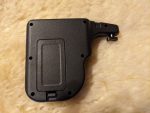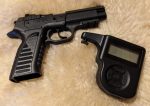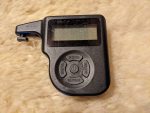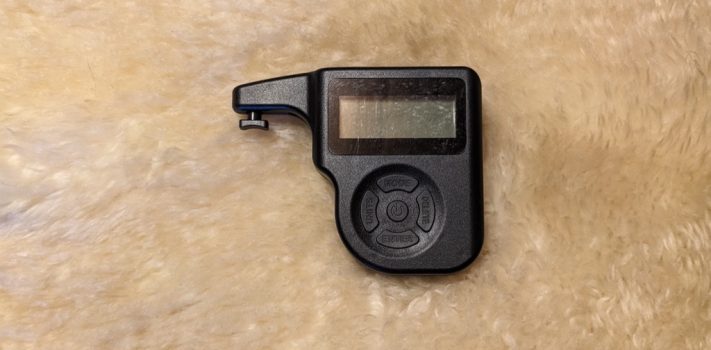The Ready Up Gear Digital Trigger Pull Gauge provides a handy, reliable, easy-to-use tool for objectively measuring trigger pull weight on a firearm. Made for Ready Up Gear by Pridefend, the gauge was available for $29.99 at the time of this writing from www.readyupgear.com.
Background
As I test various firearms, it is easy to subjectively tell that some triggers feel heavier and that some triggers feel lighter than others. But heretofore I did not have an objective means of measuring exactly how heavy or how light a particular trigger might be. So when Ready Up Gear offered to provide me with a digital trigger pull gauge, I jumped at the opportunity. About a week later, a package was delivered via USPS.
First Impressions
 The main body of the gauge is about 3 inches wide, about 4 inches tall, and about 1 inch thick. There is a 1.5 inch arm coming out of the side of the gauge upon which the sensor is located. The entire gauge is made out of black plastic. It has a battery compartment on the back, a screen, and 5 buttons on the front. The buttons are labeled with a power symbol and with the words, “units”, “mode”, “delete”, and “enter”.
The main body of the gauge is about 3 inches wide, about 4 inches tall, and about 1 inch thick. There is a 1.5 inch arm coming out of the side of the gauge upon which the sensor is located. The entire gauge is made out of black plastic. It has a battery compartment on the back, a screen, and 5 buttons on the front. The buttons are labeled with a power symbol and with the words, “units”, “mode”, “delete”, and “enter”.
The entire gauge including batteries weighs just 4.6 ounces on my battered but still effective “kitchen” scale that I never use in the kitchen.
The simple directions for the gauge are printed in large print on just one side of an 11X17 piece of paper. These directions revealed a number of interesting points:
- The unit is powered by 2 AAA batteries (not included).
- Once the batteries are installed, the unit can be turned on or off by pressing the power button.
- Pressing the “units” button will toggle between pounds/ounces and kilograms as the unit of measure.
- The mode function toggles between “peak” and “live” measures. The “peak” function records the maximum force exerted during the pull, while the “live” function shows the force currently being exerted.
- Pressing the “enter” button will accept the “peak” reading, enter it into memory and average it with other accepted readings.
- Pressing the “delete” button will delete the current reading.
- The maximum weight that the scale can measure is 12 pounds.
- The directions recommend averaging 3 to 5 readings to get a more accurate measurement.
Testing
I measured the trigger pull weight of 10 different firearms to get a sense of how the gauge operates and how effective it is as a tool. I measured the trigger pull weight of each of the firearms 5 separate times in order to get a more accurate sense of actual weight. The results were as follows:
For a Uberti 1866 Yellowboy Short Rifle in .45 Colt, the trigger pull weight measured from 6.19 to 7.2 pounds, with an average of 6.63 pounds and a mean of 6.49 pounds.
For a Savage Model 110 Storm in 6.5 Creedmoor, the trigger pull weight measured from 2.64 to 3.64 pounds, with an average of 3.04 pounds and a mean of 2.91 pounds.
 For a Rock Island Armory MAPP FS ( part 1, part 2), the single action trigger pull weight measured from 3.68 to 4.11 pounds, with an average of 3.94 pounds and a mean of 3.96 pounds. I can fire this handgun more accurately than any other 9mm handgun I have ever fired. I suspect that the relatively light trigger is a factor in this accuracy. Since the MAPP does not have a decocker, the double action trigger pull weight is primarily of academic rather than practical interest. For the record, the double action trigger pull weight measured from 9.23 to 10.08 pounds, with an average of 9.64 pounds and a mean of 9.58 pounds.
For a Rock Island Armory MAPP FS ( part 1, part 2), the single action trigger pull weight measured from 3.68 to 4.11 pounds, with an average of 3.94 pounds and a mean of 3.96 pounds. I can fire this handgun more accurately than any other 9mm handgun I have ever fired. I suspect that the relatively light trigger is a factor in this accuracy. Since the MAPP does not have a decocker, the double action trigger pull weight is primarily of academic rather than practical interest. For the record, the double action trigger pull weight measured from 9.23 to 10.08 pounds, with an average of 9.64 pounds and a mean of 9.58 pounds.
For a Pietta M1858 .44 Remington Replica, the trigger pull weight measured from 4.22 to 5.14 pounds, with an average of 4.64 pounds and a mean of 4.5 pounds.
For a Browning A5 Magnum in 12 gauge, the trigger pull weight measured from 2.04 to 2.7 pounds, with an average of 2.47 pounds and a mean of 2.56 pounds.
For a Saiga 223, the trigger pull weight measured from 4.86 to 5.75 pounds, with an average of 5.29 pounds and a mean of 5.19 pounds.
For a Savage Model 220A in 20 gauge, the trigger pull weight measured from 5.09 to 6.35 pounds, with an average of 5.83 pounds and a mean of 5.81 pounds.
For a Remington 11-48 in 16 gauge, the trigger pull weight measured from 3.81 to 4.56 pounds, with an average of 4.19 pounds and a mean of 4.11 pounds.
For a Smith and Wesson Safety Hammerless Fifth Model Top-Break Revolver, the double-action trigger pull weight measured from 10.39 to 11.16 pounds, with an average of 10.84 pounds and a mean of 10.92 pounds. (Note that this revolver is a hammerless model, so it is a “double action only” (DAO) design.
I did not initially test any rimfire firearms because I did not yet have any appropriately sized snap caps. (I did not want to dry fire rimfires without snap caps because that was very likely to do damage the rim of the chamber.)
Trigger Pull Factors
Good triggers minimize factors that may change the direction that the barrel is pointing from the time the shooter begins to squeeze the trigger until the time when the firearm discharges and the projectile or group of projectiles exits the barrel. Important trigger characteristics include weight, consistency, smoothness, and length of pull.
In general, the lighter the pull, the less likely the pull is to move the barrel from the point of aim. But if the pull is too light, it may increase the risk of an unintentional discharge.
 One way in which an excessively light trigger can increase the risk of unintentional discharge is through mechanical failure. In some firearms, the sear may release the hammer or striker when a firearm is jarred. For example, I own a Smith and Wesson Double Action Second Model Top-Break revolver that has a trigger pull weight that measured from 2.43 to 2.71 pounds, with an average of 2.63 pounds and a median of 2.68 pounds. The problem is that the trigger sear in the revolver is so worn that it sometimes spontaneously releases the hammer.
One way in which an excessively light trigger can increase the risk of unintentional discharge is through mechanical failure. In some firearms, the sear may release the hammer or striker when a firearm is jarred. For example, I own a Smith and Wesson Double Action Second Model Top-Break revolver that has a trigger pull weight that measured from 2.43 to 2.71 pounds, with an average of 2.63 pounds and a median of 2.68 pounds. The problem is that the trigger sear in the revolver is so worn that it sometimes spontaneously releases the hammer.
Another way in which an excessively light trigger can increase the risk of unintentional discharge is through something brushing the trigger before the user intends to fire. As a result, some police departments require that the handguns carried by their officers to have relatively heavy triggers. I personally favor lighter triggers. It is a basic rule of handgun safety that one should keep their finger off the trigger unless they intend to discharge a firearm. If a police officer actually needs to discharge a firearm in earnest, I want them to have the best possible chance of actually hitting their target.
A trigger that operates more consistently is also more likely to give more accurate results. Whatever influence the trigger pull has on the barrel will remain the same, resulting in more consistent results.
A smoother trigger will also tend to give more accurate results. Smoothness is a subset of consistency. Unexpected gritty spots in the triggers travel will tend to pull the barrel away from the point of aim in unexpected ways.
A shorter trigger pull will also tend to give more accurate results. A longer pull provides more opportunity for the barrel to move away from the point of aim.
Conclusions
In my testing, I found the Ready Up Gear Digital Trigger Pull Gauge to give consistent readings that corresponded well with manufacturer and reviewer reported performances for the various firearms tested. The readings were also consistent with my subjective experience of the relative pull-weight of the various triggers. As a result, I believe the tool to be accurate and reliable. I also found it to be easy to use. I am glad to have a tool that will allow me to objectively evaluate the relative trigger pull weights of various firearms in my future testing. This will allow me to give more precise and detailed information to SurvivalBlog readers as they consider the relative advantages and disadvantages of the firearms I am describing.
Disclaimer
Ready Up Gear was kind enough to provide me with a sample of their Digital Trigger Pull Gauge for testing and evaluation. Uberti loaned me a sample of their 1866 Yellowboy Short Rifle in .45 Colt for a review that I was preparing at the time of this writing. In the same manner, Savage loaned me a sample of their Model 110 Storm in 6.5 Creedmoor for a review that I was preparing at the time of this writing. Rock Island Armory had previously loaned me a sample of their MAPP FS. I subsequently purchased that sample. I tried not to let the kindness of any of these vendors interfere with the objectivity of my review, and I believe that I have succeeded. I did not receive any other financial or other inducement to mention any vendor, product, or service in this article.










